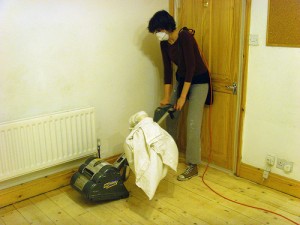 Lately, we’ve talked a bit about de-cluttering, and about ways to transform your yards in time for spring. Now for those of you with wood flooring that has perhaps been around a while or who have invested in new but unfinished wood flooring, it may be the perfect time of year to bring them back to life, too.
Lately, we’ve talked a bit about de-cluttering, and about ways to transform your yards in time for spring. Now for those of you with wood flooring that has perhaps been around a while or who have invested in new but unfinished wood flooring, it may be the perfect time of year to bring them back to life, too.
One clear advantage is that Springtime allows those windows and doors to remain open, and furnaces to be off, which cuts down on the issues of dust levels caused during the re-sanding process. And of course, when it comes to re-finishing, Springtime weather allows those windows to stay open, allowing the finish to dry faster, too.
But, how do get started on a job like this? Well, here are a few pointers to help you transform a drab, or perhaps newly installed but unfinished, wood floor into a thing of beauty just in time for Spring …
One thing you’ll want to decide is whether or not your budget allows you to hire a professional to do this job for you. It’s a commitment, and sometimes a professional can cut down on time and on the possibility of errors, too. But, assuming that you are going to do the job yourself, here is a list of considerations when contemplating the sanding and refinishing of a wood floor.
1. Put together a list of materials. Lists are helpful in making sure that everything you need all down the line is on hand. Think about safety (dust masks, goggles), basic materials (brooms, dustpans, rollers, brushes), off-of-the-shelf products (sandpaper, finish), and also some of the larger items that you’ll have to rent (a belt sander, edger, a shop vac, large fans). Talk to your local retailer about the tools you’ll need to rent to get the best results for your particular job.
2. Prepare For A Dust Storm. Sanding your floor will be the first step in the re-finishing process. Sanding the surface of a wood floor ensures that the wood will absorb the finish. But, it’s a dusty job. Clearing your room of furniture and wall hangings, and making sure that you’ve good adequate ventilation, too are great first steps. Apart from allowing dust to escape to the outside, you’ll still need to contain it as much as possible so that it doesn’t find its way to other rooms of your home. Close your vents to keep dust from getting into other rooms. Hang bedsheets on walls and in doorways to prevent the same.
3. Ensure Good Ventilation. With all of the dust, and later the fumes of the finish, you will need to make sure that airflow into your work space is a priority.
4. Inspect Your Floor For Nails and Debris. If you’ve got an older floor, materials on the surface of your wood floor that may affect the way the floor absorbs the finish will need to be removed, as will exposed nail heads that will kick up sparks if the sander hits it.
 5. Keep The Sander Moving! Once the sander is on, it’s important to cover your floor evenly. Don’t let the sander gouge your wood floor. Ask your retailer about the range of sandpaper grades you’ll need. Generally, you’ll start with a coarser grade, and graduate to a finer one. But, at every stage, make sure that an evenly sanded floor is your goal, which you’ll be able to achieve as long as the sander is in motion at all times when it’s on.
5. Keep The Sander Moving! Once the sander is on, it’s important to cover your floor evenly. Don’t let the sander gouge your wood floor. Ask your retailer about the range of sandpaper grades you’ll need. Generally, you’ll start with a coarser grade, and graduate to a finer one. But, at every stage, make sure that an evenly sanded floor is your goal, which you’ll be able to achieve as long as the sander is in motion at all times when it’s on.
6. Get Into The Corners. The belt sander will allow you to cover the open spaces. But an edger will allow you to reach the edges, and other more detailed areas.
7. Make Sure The Finish is Stirred Not Shaken. Fight against your James Bond tendencies when it comes to your finish. Shaken finish creates air bubbles which makes even layers of finish to be more of a challenge. And you want as even a spread as you can get.
8. Let Your Finish Dry Properly. Wait about three hours before applying the next coat. Once it is applied, the second coat should be allowed to stand for up to three days, so I’d advise you to …
9. Take a Holiday! Depending on the scale of the job, you may or may not have to make arrangements to be elsewhere while the finish is curing. Why not reward yourself with a weekend away? You’ll return relaxed to a floor that you can be proud of!
For more information, be sure to read this post by Extreme How-To’s Mark Clement which goes into even more detail about how to sand and refinish wood floors. Also, check out this post about how to refinish wood floors, too.
Cheers!
Rob.
![[object Object]](https://assets.builddirect.com/images/logo-blue.png?auto=format&fit=max&w=384)

















